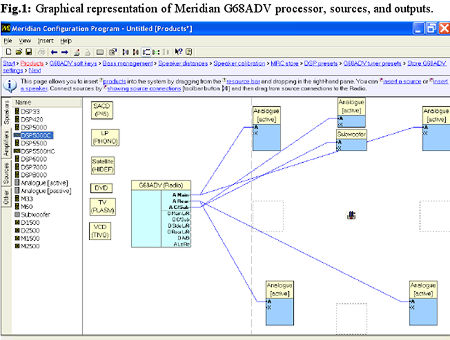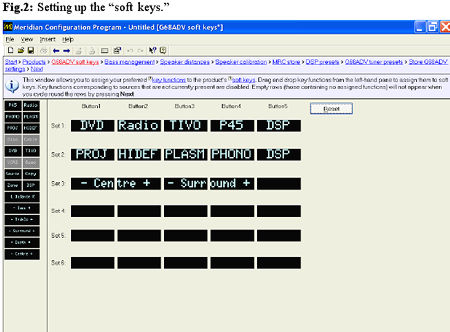Meridian G68ADV Surround Processor & G98DH DVD Player Fetch, Freddy! Fetch!
When Ken Forsythe of Meridian came over to set up the G68ADV and G98DH, he connected his laptop to the G68 with a serial cable that comes with the processor. While you can do a lot of the setup work from the front panel, you can't do it all, especially room correction. Later, I loaded the software on my own laptop as well, so I could explore with more leisure. Of course, because we used Ken's computer to configure the G68, I first had to load the configured G68 parameter file into my laptop. The software intelligently provides a Fetch command; this turned off the G68 (it must be off to be configured) and downloaded everything except the room-correction information into my laptop. Piece of cake!
The configuration can be undertaken linearly or in random fashion from a progression of nine clickable pages horizontally arranged at the top of the screen. The Start page gives you access to general setup information, links to the Meridian website, and FAQ sections. The Products page shows a graphical representation of your processor's setup (Fig.1), with other Meridian products available for dragging and dropping into your configuration. When you do this, configuration dialog boxes appear automatically, instead of requiring you to right-click and select Properties to complete your work. Right-clicking the speaker icons lets you identify a specific speaker group's bass characteristics (e.g., Large or Small), to indicate whether they'll be run full-range or use the processor's crossover.

The Soft Keys page (Fig.2) lets you assign sources to one of five front-panel buttons. With the Menu and More buttons you can jump through the six pages of soft keys quickly from the front panel, but of course you'd want to put your most-used sources on the first page. I easily added bass and treble controls just to see if I could, though I had no intention of using them.

The Bass Management page is quite complete and intelligently interactive, for the most part. While you can't select crossover slopes as you can with the Theta Casablanca, the visual interface is a treat. The slightly odd behavior that prevents even full-range speakers from running without a crossover when no center-channel is present, along with the hope that Meridian will someday allow users to independently select crossovers by speaker group, are mitigated by the G68's future-proof software. The first thing the configuration program did when it started was to check Meridian's website for updates! Similarly, firmware updates could be downloaded from the Internet and uploaded to the G68 via the same RS-232 port used for configuring the system.
The software can completely and accurately calculate speaker distances to the nearest inch and make level adjustments, generating its own broadband and impulse signals in the process. In addition, MRC (Meridian Room Correction) performs automatic digital equalization to compensate for any room anomalies. At this price point, you'd expect a calibration microphone to be included, but it's not. Instead, you can use a simple RadioShack SPL meter, which includes an RCA output that you connect to the designated analog input.
Digitally equalizing the room on the MRC page took about 20 minutes, while Ken Forsythe and I hid out in an adjoining room, where we could talk quietly while the G68 preformed its high-tech magic. As easy as it was, your dealer should be able to run through the entire G68 setup procedure, including room equalization, in less than an hour—but be sure to ask him to run it from your laptop, if you have one; otherwise, the graphic images of your room go back with him!
The G68's many DSP modes can be adjusted from the front panel, but there's no doubt that a big picture is worth a thousand words. Besides selecting the default modes for each source, you can tweak to your heart's delight. (Meridian has a thing for their admittedly excellent Trifield mode—it's the chef's choice—but you might want to do your own cooking.) The excellent bubble help in the DSP section lets you point to almost any setting and get instant information on its function and use. I used this section to turn room correction off in Direct mode, as discussed in the review.
The software for such a complex product can be complex or, as in the case of the Meridian G68ADV, a pure pleasure to use. Success is making the difficult look simple; here, Meridian has succeeded.—FM













































